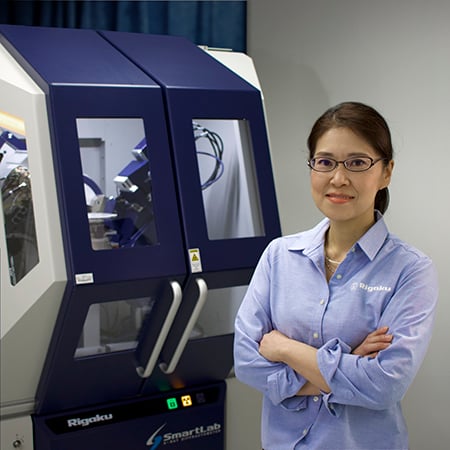Background Reduction for Iron Oxide with CuKα X-rays using XRF Mode
Introduction
A Cu target is widely used for X-ray diffraction measurements because it efficiently generates X-rays due to its excellent thermal conductivity and is inexpensive. Additionally, the wavelength of the characteristic line Kα1 allows observation up to a d-value of 0.82 Å (2θ = 140 ̊), so it is suitable for determining crystal structures at atomic position level. Despite these advantages, diffraction profiles for Fe compounds exhibit high backgrounds due to fluorescent X-rays generated by Fe, which makes it difficult to distinguish low-intensity diffraction peaks from the background. Here, we illustrate diffraction results with low background and a high P/B ratio obtained using the X-ray fluorescence reduction mode of a 2D detector with a Cu source.
Measurements and results
Figure 1 shows the diffraction profiles of iron(III) oxide observed using Cu and Co sources, two detectors (D/teX and HyPix-400), and different energy modes (standard (Std) and X-ray fluorescence reduction (XRF)) (a), and the profiles normalized by the background (b). The ratios of peak intensity (P) and background (B) of the main peak (Q ≈ 2.3 Å⁻¹) of iron oxide are shown in Table 1. The backgrounds using Std mode of D/teX and HyPix-400 with a Cu source are higher than those using Std mode of those detectors with a Co source due to the generation of fluorescent X-rays by the Fe atoms. However, the P/B ratio with a Cu source improves by a factor of 9 compared to the Std mode of D/teX and 39 times compared to the HyPix-400 when the detector is operated in XRF mode. In addition, the results for XRF mode of HyPix-400 with a Cu source are approximately 8 times better than with the Std mode of HyPix-400 with a Co source. As described above, even with a sample containing iron, diffraction profiles with low background and high P/B ratio can be obtained using the XRF mode of HyPix-400 without changing the Cu target.

Figure 1: The observed diffraction profiles (a) and normalized profiles (b) of Fe₂O₃ by Cu and Co sources, detector types, and their energy modes (Std: standard mode, XRF: X-ray fluorescence reduction mode ).
Table 1. Peak(P)-to-background(B) ratio of the main peak (Q ≈ 2.3Å⁻¹) of Fe₂O₃
| X-ray | Detector | Energy mode | P | B | P/B |
| Cu | D/teX | Std | 12131 | 3723 | 3 |
| XRF | 6076 | 224 | 27 | ||
| HyPix-400 | Xtd | 8655 | 4281 | 2 | |
| XRF | 3606 | 46 | 78 | ||
| Co | HyPix-400 | Xtd | 23688 | 2265 | 10 |
| XRF | 14559 | 751 | 19 |
Related products
MiniFlex
New sixth-generation general purpose benchtop XRD system for phase i.d and phase quantification
Learn More
Contact Us
Whether you're interested in getting a quote, want a demo, need technical support, or simply have a question, we're here to help.


